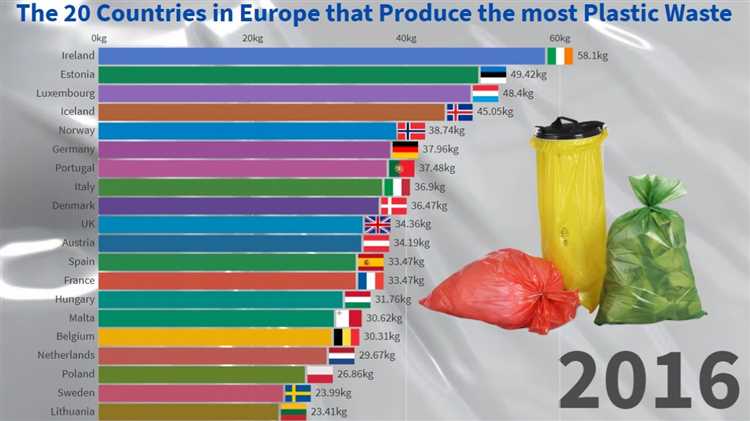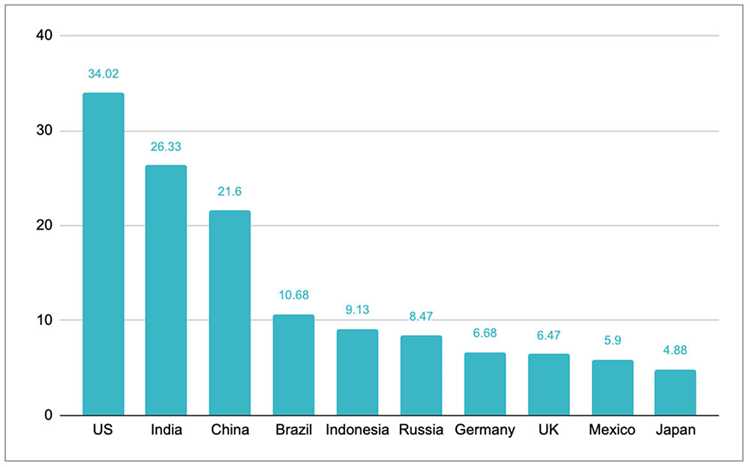
Plastic waste has become a global environmental crisis, with production rates increasing at an alarming rate. Among the countries that contribute significantly to this problem, one stands out – China.
China has been the world’s largest producer of plastic for many years, accounting for a significant portion of the global production. This rapid growth in plastic production is due to a variety of factors, including increased consumer demand, rapid urbanization, and the country’s booming manufacturing industry.
China’s plastic production has had severe consequences for the environment and public health. The country’s limited waste management infrastructure has resulted in a significant amount of plastic waste ending up in rivers, oceans, and landfills. This has led to devastating impacts on marine life and ecosystems, as well as posing a threat to human health.
Efforts to address the issue have been made, with China implementing stricter regulations on plastic production and waste management. However, the scale of the problem remains enormous, and it will require a concerted global effort to tackle the issue of plastic pollution.
As the country with the highest plastic production rates, China serves as a stark reminder of the urgent need for sustainable solutions and global cooperation to address the plastic waste crisis.
- Overview of Plastic Production
- The Leading Countries in Plastic Production
- The Environmental Impact
- Factors Contributing to High Plastic Production
- 1. Industrialization and Economic Growth
- 2. Consumer Culture and Disposable Lifestyle
- 3. Lack of Effective Recycling Infrastructure
- Effects of Plastic Production on the Environment
- Comparison of Plastic Production Rates Across Countries
- Measures to Reduce Plastic Production
- 1. Plastic Bag Bans and Taxation
- 2. Promotion of Recycling and Waste Management
- 3. Encouraging Sustainable Packaging Alternatives
- 4. Research and Development of Bioplastics
- Q&A:
- Which country produces the highest amount of plastic?
- How much plastic does China produce?
- What are the plastic production rates in different countries?
- Is plastic production increasing globally?
Overview of Plastic Production
Plastic production has skyrocketed in recent decades, contributing to the growing plastic pollution crisis worldwide. It has become an integral part of our daily lives, with applications in various industries such as packaging, construction, electronics, and automotive.
The process of plastic production involves extracting raw materials like petroleum, natural gas, and coal, which are then processed and transformed into polymers. Polymers are the building blocks of plastic, and they can be molded into different forms and shapes.
The Leading Countries in Plastic Production
Several countries dominate the global plastic production market, with China being the world’s largest producer. Its massive manufacturing industry and high population contribute to its significant plastic output. Other top producers include the United States, India, Japan, and Germany.
The Environmental Impact
Plastic production has severe environmental consequences. The extraction and processing of fossil fuels for plastic production release greenhouse gases, contributing to climate change. Additionally, plastic waste poses a serious threat to ecosystems, marine life, and human health.
Plastic pollution can be found in oceans, rivers, and landfills, taking hundreds of years to decompose. This pollution not only harms wildlife but also enters the food chain, potentially exposing humans to harmful chemicals.
Efforts to Reduce Plastic Production and Pollution
Recognizing the need to tackle the plastic pollution crisis, many countries and organizations have implemented measures to reduce plastic production and promote recycling. Some of the efforts include banning single-use plastic items, implementing extended producer responsibility programs, and promoting research and development of biodegradable alternatives to traditional plastic.
The fight against plastic pollution requires collective action from governments, businesses, and individuals. By reducing plastic production and consumption, promoting recycling and waste management, and adopting sustainable alternatives, we can work towards a cleaner and healthier future.
In conclusion, plastic production has reached alarming levels, and its impact on the environment cannot be ignored. It is essential to address the issue of plastic pollution through both individual and collective efforts to mitigate its adverse effects and protect our planet for future generations.
Factors Contributing to High Plastic Production

Several factors contribute to high plastic production rates in a country.
1. Industrialization and Economic Growth
Industrialization and economic growth significantly contribute to high plastic production. As a country develops and its economy grows, there is an increased demand for plastic products in various sectors such as packaging, construction, automotive, and electronics. This leads to higher plastic production as industries strive to meet the market demand.
2. Consumer Culture and Disposable Lifestyle
A consumer culture that emphasizes convenience and a disposable lifestyle is another factor contributing to high plastic production. In countries where there is a high demand for single-use plastic products like bottles, bags, and packaging, the production of these items increases to meet consumer needs. The use-and-throw mentality fuels the demand for plastic, leading to its high production rates.
3. Lack of Effective Recycling Infrastructure

The lack of effective recycling infrastructure is also a significant factor contributing to high plastic production. In countries where recycling facilities and programs are lacking or inefficient, a large proportion of plastic waste ends up in landfills or is improperly disposed of. This encourages the production of new plastic rather than promoting the recycling and reuse of existing materials.
In conclusion, industrialization and economic growth, consumer culture, and the lack of effective recycling infrastructure are some of the key factors contributing to high plastic production in a country. Addressing these factors through sustainable practices, promoting recycling, and reducing reliance on single-use plastics can help mitigate the environmental impact of plastic production.
Effects of Plastic Production on the Environment
Plastic production has had severe and far-reaching effects on the environment. These include:
1. Pollution of Land and Water: Plastic waste often ends up in landfills or is improperly disposed of, leading to the pollution of land and water sources. Plastic does not decompose quickly and can persist in the environment for hundreds of years.
2. Harm to Wildlife: Many animals mistake plastic for food or get entangled in it, leading to injury or death. Marine animals are particularly affected, with millions of seabirds, turtles, dolphins, and other marine species dying each year due to plastic pollution.
3. Disruption of Ecosystems: Plastic pollution disrupts ecosystems by altering habitats, reducing biodiversity, and impacting the food chain. It can smother coral reefs, suffocate aquatic plants, and contaminate soil, affecting the health and balance of ecosystems.
4. Health Risks: Plastics contain harmful chemicals like bisphenol A (BPA) and phthalates, which can leach into the environment and pose health risks to humans and animals. These chemicals have been linked to various health issues, including cancer, reproductive problems, and developmental disorders.
5. Climate Change Impact: The production of plastic requires fossil fuels, leading to greenhouse gas emissions and contributing to global climate change. Additionally, the incineration of plastic waste releases toxic gases into the atmosphere.
6. Microplastic Contamination: Plastic debris breaks down over time into tiny particles known as microplastics, which can be found in air, water, and even consumed by humans through food and water. The long-term effects of microplastic contamination on human health are still not fully understood.
Overall, the high levels of plastic production and its improper disposal have had a devastating impact on the environment, wildlife, ecosystems, and human health. Urgent and widespread action is necessary to mitigate these effects and transition to more sustainable alternatives.
Comparison of Plastic Production Rates Across Countries
Plastic production is a global issue that has significant environmental impacts. Here, we compare the plastic production rates across different countries to understand the scope of the problem and identify the leading producers of plastic.
1. China: China is the world’s leading producer of plastic, contributing a significant portion to global plastic production. The country’s rapid industrialization and population growth have driven high plastic consumption and production rates.
2. United States: As one of the largest economies, the United States has a significant plastic production rate. The country’s consumption patterns and large manufacturing sector contribute to its high plastic production levels.
3. India: India is emerging as a major player in plastic production, driven by its growing middle class and increasing consumer demand. The country’s plastic production rates have been rising steadily in recent years.
4. Germany: Germany has a well-developed industrial sector and is known for its manufacturing capabilities. As a result, the country has a substantial plastic production rate.
5. Brazil: With its vast agricultural and industrial sectors, Brazil also has a significant plastic production rate. The country’s expanding consumer market and increasing industrial output contribute to the high plastic production levels.
6. Japan: Japan has a highly developed manufacturing sector and is known for its technological advancements. This contributes to its plastic production rates, although they are relatively lower compared to the larger economies.
These countries represent some of the highest plastic producers globally. However, plastic production rates vary across countries, depending on factors such as population, economic development, and industrial capacity.
It is crucial for these countries and others globally to address the issue of plastic production and strive for more sustainable alternatives. By reducing plastic consumption and promoting recycling and reuse, we can work towards mitigating the environmental impact of plastic production.
Measures to Reduce Plastic Production
Plastic production has become a global concern due to its adverse effects on the environment. To address this issue, several measures have been implemented to reduce plastic production:
1. Plastic Bag Bans and Taxation
One effective measure to reduce plastic production is the implementation of plastic bag bans or taxation. Many countries and cities have enforced restrictions on the use of single-use plastic bags by either imposing a ban on their distribution or implementing taxes on their consumption. This encourages people to switch to reusable bags or alternative eco-friendly options, leading to a decrease in plastic bag production.
2. Promotion of Recycling and Waste Management
An essential aspect of reducing plastic production is promoting recycling and waste management. Governments and organizations are investing in recycling facilities and creating awareness campaigns to educate consumers on the importance of proper waste segregation and recycling practices. By implementing effective recycling systems, a significant amount of plastic waste can be diverted from landfills and used to produce new products, reducing the need for virgin plastic production.
3. Encouraging Sustainable Packaging Alternatives
Another measure to reduce plastic production is the encouragement of sustainable packaging alternatives. Businesses and manufacturers are increasingly adopting eco-friendly packaging materials such as biodegradable plastics, compostable materials, and paper-based packaging. By shifting towards more sustainable options, the demand for traditional plastic packaging decreases, leading to a reduction in overall plastic production.
4. Research and Development of Bioplastics
Investing in research and development of bioplastics is instrumental in reducing plastic production. Bioplastics are derived from renewable resources, such as plant-based materials, and have a lower environmental impact compared to traditional plastics made from fossil fuels. By promoting the development of bioplastics and their widespread adoption, the dependency on petroleum-based plastics can be reduced, ultimately minimizing plastic production rates.
To combat the growing plastic pollution problem, it is crucial to implement a combination of these measures. By raising awareness, implementing regulations, promoting sustainable alternatives, and investing in research, countries can take significant steps towards reducing plastic production and protecting the environment.
Q&A:
Which country produces the highest amount of plastic?
The country with the highest plastic production rates is China, producing around 30% of the world’s plastic.
How much plastic does China produce?
China produces around 30% of the world’s plastic, making it the largest producer of plastic globally.
What are the plastic production rates in different countries?
The plastic production rates vary across countries. China leads with around 30% of global plastic production, followed by the United States, Europe, and India.
Is plastic production increasing globally?
Yes, plastic production is increasing globally. The demand for plastic products has been rising rapidly, especially in developing countries.